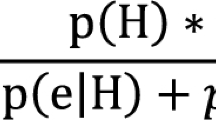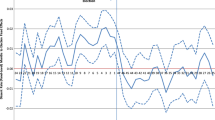Abstract
Ex aequo et bono compensations refer to tribunal’s compensations that cannot be determined exactly according to the rule of law, in which case the judge relies on an estimate that seems fair for the case at hand. Such cases are prone to legal uncertainty, given the subjectivity that is inherent to the concept of fairness. We show how basic principles from statistics and machine learning may be used to reduce legal uncertainty in ex aequo et bono judicial decisions. For a given type of ex aequo et bono dispute, we consider two general stages in estimating the compensation. First, the stage where there is significant disagreement among judges as to which compensation is fair. In that case, we let judges rule on such disputes, while a machine tracks a certain measure of the relative differences of the granted compensations. In the second stage that measure, which expresses the degree of legal uncertainty, has dropped below a predefined threshold. From then on legal decisions on the quantity of the ex aequo et bono compensation for the considered type of dispute may be replaced by the average of previous compensations. The main consequence is that this type of dispute is, from this stage on, free of legal uncertainty.
Similar content being viewed by others
References
Alarie B (2016) The path of the law: towards legal singularity. Univ Toronto Law J 66(4):443–455
Chandra TK (2012) Laws of large numbers. Narosa Publishing House, New Delhi
Coontz P (2000) Gender and judicial decisions: do female judges decide cases differently than male judges? Gender Issues 18:59–73
Elavarasan N, Mani K (2015) A survey on feature extraction techniques. Int J Innov Res Comput Commun Eng 3(1)
Ellsworth P (2005) The Cambridge handbook of thinking and reasoning. ch. Legal reasoning, Cambridge University Press, New York. https://repository.law.umich.edu/book_chapters/51/
Frey CB, Osborne MA (2017) The future of employment: how susceptible are jobs to computerisation?’. Technol Forecast Soc Change 114:254–280
Gorodetsky V, Samoylov V (2010) Feature extraction for machine learning: logic–probabilistic approach. In: Roceedings of the Fourth international workshop on feature selection in data mining, pp 55–65
Johnson DG (2006) Computer systems: moral entities but not moral agent. Ethics Inf Technol 8(4):195–204
Kulik CT, Perry EL, Pepper MB (2003) Here comes the judge: the influence of judge personal characteristics on federal sexual harassment case outcomes. Law Hum Behav 27:69–86
Liu JZ, Li X (2019) Legal techniques for rationalizing biased judicial decisions: evidence from experiments with real judges. J Empir Legal Stud 16:630–670
Malgieri G (2019) Automated decision-making in the EU Member States: the right to explanation and other “suitable safeguards’’ in the national legislations. Comput Law Secur Rev 35(5):105327
Seneta E (2013) A tricentenary history of the law of large numbers. Bernoulli 19(4):1088–1121
Sourdin T (2018) Judge v robot? Artificial intelligence and judicial decision-making. Univ New South Wales Law J 41(4):1114–1133
Sourdin T, Cornes R (2018) The responsive judge, 1st ed. Singapore: Springer, ch. Do Judges Need to Be Human? The Implications of Technology for Responsive Judging, pp 87–119
Author information
Authors and Affiliations
Corresponding author
Additional information
Publisher's Note
Springer Nature remains neutral with regard to jurisdictional claims in published maps and institutional affiliations.
Rights and permissions
About this article
Cite this article
De Mulder, W., Valcke, P. & Baeck, J. A collaboration between judge and machine to reduce legal uncertainty in disputes concerning ex aequo et bono compensations. Artif Intell Law 31, 325–333 (2023). https://doi.org/10.1007/s10506-022-09314-x
Accepted:
Published:
Issue Date:
DOI: https://doi.org/10.1007/s10506-022-09314-x




